《欧洲文化导论》课程教学资源:《欧洲文化入门 European Culture An Introduction》PDF电子书(一、二)
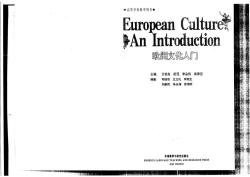
。高等学校教学用书◆ European Culture 是An Introduction 欧洲文化人门 主编:王佐良祝珏李品伟高厚堃 编著:司徒双王立礼李宪生 刘新民朱永涛徐海昕 外酒教学与研究出版社 FOREIGN LANGUAGE TEACHING AND RESEARCH PRESS 北京BENG
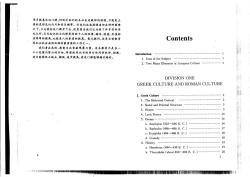
学多数春欢这门课,但吸引他们的未必全是教师的讲授,可能更主 要的是彩色幻灯片和音乐磁带。而我们这些授课者却在种种因难 之下,立志要把这门课开下去,这是因为我们认为徐了许多实际用 处之外,文化知识和文化修养有助于人的性情、趣味、道德、价值标 准等等的提高,也就是人的素质的提高。毫无疑问,这是当前教育 Contents 界和全社会亚须加强的最重要的工作之一。 我们身在高校,愿意为此贡献锦薄力量。这本教材只是在一 个小范国内努力的开始,希望使用此书的同行和同学就评、指教, ntroduction…1 使它能够改正缺点、错误,逐步提高,使这门课能够越开越好。 1.Uses of the Subject............................... 2.Two Major Elements in European Culture ............. 1 DIVISION ONE GREEK CULTURE AND ROMAN CULTURE I.Greek Culture…2 1.The Historical Context................2 2.Social and Political Structure......3 3.Homer… 3 4.Lyric Poetry… 3 5.Drama……… 14 a.Aeschylus(525-456B.C.)…14 b.Sophocles (496-406 B.C.)................ 1) c.Euripides(484-406B.C.)……1 8 d.Comedy…l8 6.History…19 a.Herodotus(484-430B.C.)… 19 b.Thucydides(about460-404B.C.)…20 山深家不平那1师+事科新餐沉
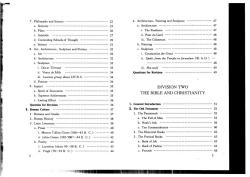
7.Philosophy and Science..22 4.Architecture,Painting and Sculpture......................47 23 a.Architecture…a…47 b。Pat0*……+*t4…444 26 i.The Pantheon............................... 47 C,Aristotle**+…………………4 27 i.Pont du Gard…… 48 d.Contending Schools of Thought ............................29 ii.The Colo8seum……48 e,Science……31 b.Painting...... 48 8.Art,Arehitecture,Sculpture and Pottery......32 c.Sculpture……48 a,Art……32 i.Constantine the Great……48 b.Architecture…32 ii.Spoils from the Temple in Jerusalem (81 A.D.) C.Sculpture… 33 …48 i.Discus Thre0ter… 33 it.She-wolf…49 ii.Venus de Mil0…34 Questi0 ns for Revision……49 iii.Laocoon group about 125 B.C....................34 d.Pottery…34 9.Impact…35 DIVISION TWO a.Spirit of Innovation…… 35 THE BIBLE AND CHRISTIANITY b.Supreme Achievement........................... c.Lasting Effect………36 Question for Revision.................36 I.General Introduction...........51 夏.Roman Culture…37 I.The old Testament.............52 1.Romans and Greeks..........37 l.The Pentateuch……52 2.Roman History… a.The Fall of Man…53 3.Latin Literature........39 b.Noah's Ark …56 a.Pr08e……40 c.Ten Commandments.......................60 i.Marcus Tullius Cicero (106-43 B.C.)......40 2.The Historical Books................62 i.Julius3Caes8r(102/100?-44B.C.)…42 3.The Poetical Books......63 b.P0etry…43 a.Book of Job 63 i.Lucretius (about 93-50 B.C.).....................43 b.Book of Psalms................ 64 i.Virgil(70-19B.C.)…44 C.Proverb…66 2 3
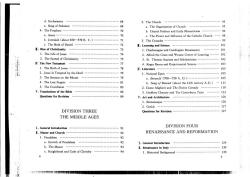
d.Ecclesiastes…68 2.The Church…g5 e,Song of Solomon… 68 a.The Organization of Church …95 4.The Prophets…70 b.Church Fathers and Early Monasticism ..................96 8,Am0844+…4+………*……44 70 c.The Power and Influence of the Catholic Church .98 b.Jeremiah (about 650-570 B.C.).....................71 3.The Crusades…99 c.The Book of Daniel……72 里.Learning and Science…l01 Rise of christianity...... 73 1.Charlemagne and Carolirgian Renaissance ..........101 1.The Life of Jesus 74 2.Alfred the Great and Wessex Centre of Learning... 102 2.The Spread of Christianity 75 3.S.Thomas Aquinas and Scholasticism……f 102 N.The New Testament......77 4.Roger Bacon and Experimental Science.................... 103 1,The Birth of Jesus… 78 N.Literature.. 105 2.Jesus Is Tempted by the Devil............................... 79 1.National Epics… 105 3.The Sermon on the Mount.......................79 a.Beowulf(700-750A.D.).105 4.The Last Supper …81 b.Song of Roland (about the 12th century A.D.)111 5.The Crucifixion…… 83 2.Dante Alighieri and The Divine Comedy.......118 V.Translations of the Bible.....86 3.Geoffrey Chaucer and The Canterbury Tales 123 Questions for Revision 89 V.Art and Architecture 44…126 1.Romanes3que…126 2.Gothic............. 127 DIVISION THREE Questi0n3 for Revision…… 127 THE MIDDLE AGES I.General Introduction.91 DIVISION FOUR I.Manor and Church…92 RENAISSANCE AND REFORMATION 1.Feudalism++4+…+…… 92 a.Growth of Feudalism........................... 92 I.General Introduction 129 b.The Manor 93 I.Renaissance in Italy................... 130 c.Knighthood and Code of Chivalry……,94 1.Historical Background……130 4 5 行家
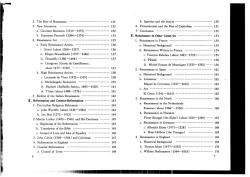
2.The Rise of Humanism...................................131 b.Ignatius and the Jesuits...................150 3.New Literature................132 6.Protestantism and the Rise of Capitalism ................ 151 a.Giovanni Boccaccio (1313-1375)........................132 7.C0 nclusion…152 b.Francesco Petrarch (1304-1374).......................133 N.Renaissance in Other Countries.................. 153 4.Renaissance Art+*……*+…………1 135 1.Renaissance in France........................................... 154 a.Early Renaissance Artists................................136 a.Historical Background.............................154 i.Giotto (about 1266-1337).........................136 b.Renaissance Writers in France..........................154 ii.Filippo Brunelleschi (1377-1446).................137 i.Francois Rabelais (about 1483-1553)...............154 i.Donatello(1386-1466)…137 i.Pleiade…… 156 iv.Giorgione (Giorio de Castelfranco, iii.Michel Eyques de Montaigne (1533-1592)......156 about1477-1510)…137 2.Renaissance in Spain......... 161 b.High Renaissance Artists............................138 a.Historical Background......................... 161 i.Leonardo da Vinci (1452-1519).....................138 b.Literature………l62 ii.Michelangelo Buonarroti..............139 Miguel de Cervantes (1547-1616).................162 iii.Raphael (Raffaello Sancio,1483-1520)........141 C.Art……165 iw,Titian(about1488-1576)……141 El Gre00(1541—1614)…+…165 5.Decline of the Italian Renaissance...................142 亚.Reformation and Counter-Reformation…l43 3.Renaissance in the North................166 a.Renaissance in the Netherlands 1.Pre-Luther Religious Reformers.............................144 a.John Wycliffe (about 1330-1384)...............144 Erasmus (about 1466?-1536)...........................166 b.Jan Hus(1372-1415)……144 b.Renaissance in Flanders 2.Martin Luther (1483-1546)and His Doctrines.....145 Pieter Bruegel (the Elder)(about 1525-1569).....167 a.Beginning of the Reformation.........................145 c.Renaissance in Germany.................................168 b.Translation of the Bible...........................145 i.Albrecht Durer (1471-1528).................168 c.Gospel of Love and Idea of Equality..........146 i.Hans Holbein(the Younger)…l69 3.John Calvin (1509-1564)and Calvinism..........147 4.Renaissance in England.........................169 4.Reformation in England................147 a.Historical Background..................169 5.Counter-Reformation.......... 149 b.Thomas More(1477-1535)…:…170 a.Council of Trent................................... 149 c.William Shakespeare (1564-1616)....................176 6 7
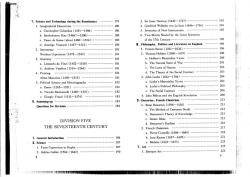
V.Science and Technology during the Renaissance.179 3.Sir Isaac Newton(1642-1727)……193 1,Geographical Discoveries………180 4.Gottfried Wilhelm von Le bniz (1646-1716)...........194 a.Christopher Columbus (1451-1506)............180 5.Invention of New Instruments...........................195 b.Bartholomeu Dias (1466?-1500)........................ 180 6.Two Merits Shared by the:Great Scientists c.Vasco da Gama (about 1460-1524)..................... 180 of the17 th Century……196 d.Amerigo Vespucci (1457-1512)................. 180 M.Philosophy,Politics and Literature in England.196 2.Astronomy…i… 181 1.Francis Bacon (1561-1626).................................196 Nicolaus Copernicus (1473-1543) 181 2.Thomas Hobbes (1588-1679)...................200 3.Anatomy… 181 a.Hobbes's Materialist Views.......................200 a.Leonardo da Vinci(1452-l519)…181 b.The Natural State of War........................201 b.Andreas Vesalius (1514-1564) 181 c.The Laws of Nature… 202 4,Printing…181 d.The Theory of the Social Contract..................... 203 Aldus Manutius(1450-1515)……181 3.John Locke(1632-1704)… 204 5.Political Science and Historiography …182 a.Locke's Materialist Views..............................204 a.Dante(1265—1321)…182 b.Locke's Political Philosophy..................205 b.NiccolòMachiavelli(1469-1527)…182 c.The Social Contract.......... 206 c.Giorgio Vosari (1511-1574).......................... 183 4.John Milton and the English Revolution …208 M.Summing-up… 183 N.Descartes;French Classicism.......... 13 Questions for Revision...........184 1.Rene Descartes (1596-1650) 213 a.The Method of Cartesian Doubt 214 b.Descartes's Theory of Knowledge.......215 DIVISION FIVE c.Innate Ideas………215 d.Descartes's Dualism.............. 216 THE SEVENTEENTH CENTURY 2.French Classicism...217 a.Pierre Corneille(1606-1684)…218 I.General Introduction……186 b.Jean Racine(1637-1699)…… 221 夏.Science…l87 c.Molière(1622-1673)…223 1.From Copernicus to Kepler........ 187 V.Art…225 2.Galileo Galilei (1564-1642)..............190 1.Baroque Art… 225 8 9 7了厚忍补和
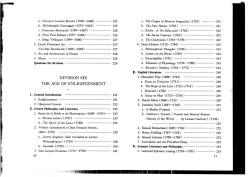
a.Giovanni Lorenzo Bernini (1598-1680)...............225 a.The Origin of Human Inequality (1755)..........241 b.Michelangelo Caravaggio (1573-1610) 225 b.The New Heloise(1761)…241 e.Francesco Borromini (1599-1667)...............226 c.Emile,or On Education (1762)......................242 d.Peter Paul Rubens(1577-1640)……226 d.The Social Contract(1762)……242 e.Diego Velazquez(1599-1660)……227 e.TheC0 nfessions(1764-1770)…242 2.Dutch Protestant Art...............227 4.Denis Diderot (1713-1784)...............................243 Van Rijn Rembrandt (1606-1669).........................227 a.Philosophical Thoughts(1746)…243 3.Art and Architecture in France......................228 b.Letters on the Blind(1749)…243 4.Music…229 c.Encyclopedie (1751)...............................243 Questi0 ns for Revisi0n…*……+……… 229 d.Elements of Physiology(1774-1780)……243 e.Rameau's Nephew (1761-1774)....................244 夏.English Literature…248 DIVISION SIX 1.Alexander Pope (1688-1744)...........................248 THE AGE OF ENLIGHTENMENT a.Essay on Criticism (1711)..................248 b.The Rape of the Lock (1712-1714) …248 c.Dunciad(1728)……,249 I.General Introduction …231 d.Essay on Man (1733-1734)..................... 249 1.Enlightenment…231 2.Daniel Defoe(1660-1731)…250 2.Historical Context..................233 3.Jonathan Swift (1667-1745).........................251 I.French Philosophy and Literature.............235 a.A Modest Proposal...............251 1.Baron de la Brede et de Montesquieu (1689-1755)......235 b.Gulliver's Travels (Travels into Several Remote a.Persian Letters(1721))…235 Nations of the World...by Lemuel Gulliver)(1726) b.The Spirit of the Laws (1748).....................235 ……252 2.Voltaire (pseudonym of Jean Francois Arouet, 4.Samuel Richardson (1689-1761)........................252 1694—1778)…239 5.Henry Fielding(1707-1754)……252 a.Lettres Anglaise (also circulated as Lettres 6.Samuel Johnson(1709-1784)………253 Philose0 phiques)(1739)…240 7.Journalism and the Periodical Essay.................253 b.Candide(1758)……240 N.German Literature and Philosophy.....255 3.Jean-Jacques Rous5seau(1712-1778)…+…241 1.Gotthold Ephraim Lessing (1729-1781)...................255 10 11 生中商获擅
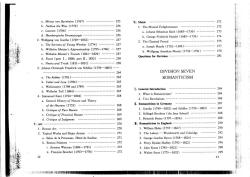
a..Minna von Barnhelm (1767)........................... 255 …272 b.Nathan the Wise(1779)…256 1.The Musical Enlightenment ……272 c.La0c00n(1766)……256 a.Johann Sebastian Bach (1685-1750)................... 273 d.Hamburgische Dramaturgie............. 256 b.George Friderick Handel (1685-1759) ……274 2,Wolfgang von Goethe(1749-1832)…257 2.The Classical Period275 a.The Sorrows of Young Werther (1774).............. 257 a.Joseph Haydn (1732-1309)...........................277 b..Wilhelm Meister's Apprenticeship (1795-1796).257 b.Wolfgang Amadeus Mozart (1756-1791).........278 c.Wilhelm Meister's Travels(1821-l829)…257 d.Faust(part I,1808;partⅡ,1832)258 Questions for Revision..............................281 e.Poetry and Truth (1811-1831)........................258 3.Johann Christoph Friedrich von Schiller (1759-1805)...... ………264 DIVISION SEVEN a.The Robber (1781)............265 ROMANTICISM b.Cabal and Love (1784).............................265 c.Wallenstein(1798and1799)…265 d.withelm Tel (1804)................................265 I.General Introduction ……284 4.【mmanuel Kant(1724-1804)…2 1.What is Romanticism?……284 68 a.General History of Nature and Theory 2.Two Revolutions....................286 of the Heavens(1755)… 268 重.Romanticism in Germany…287 b.Critique of pure Reason.............. 268 1.Goethe(1749-1832)and Schiller(1759-1805)…287 c.Critique of Practical Reason..................269 2.Schiegel Brothers (the Jena School)....................288 d.Critique of Judgment……269 3.Heinrich Heine (1797-1856)........................... 288 V.Art……270 亚.Romanticism in England…290 1.R00oC0Art…270 1.William Blake(1757-1827)…… 290 2.Typical Works and Major Artists....................271 2.The Lakers-Wordsworth and Coleridge …292 a.Salon de la Princesse,Hotel de Soubise ...........271 3.George Gordon Byron (1788-1824).................... 294 b.Rococo Painters……272 4.Percy Bysshe Shelley (1792-1822).....................296 i.Antoine Watteau (1684-1721) 有”4*4+4中 272 5.John Keats(1795—1821)… 298 ii.Francois Boucher (1703-1770)....................272 6.Walter Scott(1771一1832)……… 299 12 13 工乘装
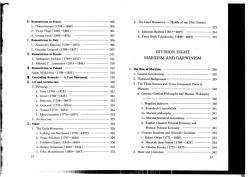
V.Romanticism in France.................... 300 2.The Later Romantics-Middle of the 19th Century 1.Chateaubriand (1768-1848)..........300 0……333 2.Victor Huge0(1802-1885)……302 a.Johannes Brahms (1833-1897).....................334 3.George Sand(1804-1876)…305 b.Peter Ilitch Tchaikovsk:y (1840-1893)................335 V.Romanticism in Italy..........................306 1.Alessandro Manzoni (1785-1873).......................306 2.Giacomo Leopardi(1798-1837)……307 DIVISION EIGHT W.Romanticism in Russia..........................311 1.Aleksander Pushkin (1799-1837) ………311 MARXISM AND DARWINISM 2.Mikhail Y.Lermontov (1814-1841)....................314 M.Romanticism in Poland...........................315 I.The Rise of Marxism 414+…54404444…339 Adam Mickiewicz (1798-1855)......................315 1.General Introduction……339 VI.Concluding Remarks-A True Movement ..........319 2.Historical Background.......339 K.Art and Architecture....................320 3.The Three Sources and Three Component Parts of 1,Painting8……………320 Marxism…4…340 a.Goya(17461828)…321 b.David(1748-1825)…322 a.German Classical Philosophy and Marxist Philosophy c.Delacroix(1798-1863)…323 ……340 d.Gericault(1791-1824)…324 i,Hegelian dialectics*……t…*…340 e.Turner(1775-1851)+…324 i.Feuerbach's materialism……341 f.John Constable (1776-1837).........................325 iti.Marxist philosophy……341 2.Architecture…325 iv.Marxist historical materialism....................349 X.Musi0…325 b.English Classical Political Economy and 1.The Early Romantics..............326 Marxist Political Economy...........351 a.Ludwig van Beethoven (1770-1827).................326 c.Utopian Socialism and Scientific Socialism ..........353 b.Franz Schubert(1797-1828)…329 i.Robert0wen(1771一1858)…354 c.Frederic Chopin (1810-1849).................330 ii.Henri de Saint-Simon (1760-1825)..............354 d.Robert Schumann (1810-1856)..................331 iii.Charles Fourier (1772-1837)....................354 e.Felix Mendelssohn (1809-1847)........................332 4.Marx and Literature……362 14 15 中年于3438隔牌
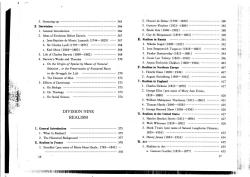
5,Summing-up…365 2.Honore de Balzac (1799--1850)......................... 380 夏.Darwinism……… 366 3.Gustave Flaubert (1821--1880)...................385 l,General Introduction………… 366 4.Emile Zola(18401902)…388 2.Ideas of Evolution Before Darwin........367 5.Guy de Maupassant (1850-1893)......................... 390 a.Jean-Baptiste de Monet Lamarck (1744-1829)......367 重.Realism in Russia…391 b.Sir Charles Lyell (1797-1875)........................368 1.Nikolai G0gol(1809-1852)…392 c.Karl Marx(1818-1883)…368 2.Ivan Sergeyevich Turgerev(1818-1883) 393 3.Life of Charles Darwin (1809-1882).................... 368 3.Fyodor Dostoyevsky(1821-1881)……394 4.Darwin's Works and Theories..............................370 4.Count Leo Tolstoy (1823-1910)...................396 a.On the Origin of Species by Means of Natural 5.Anton Pavlovich Chekhov (1860-1904)................. 403 Selection,or the Preservation of Favoured Races N.Realism in Northern Europe.............. 407 in the Struggle for Life.............................370 1.Henrik Ibsen(1828-1906)…407 b.The Descent of Man....................................373 2.August Strindberg(1849-1912)…416 5.Effects of Darwinism……………·373 V.Realism in England… 417 a.On Biol0gy…373 1.Charles Dickens(1812-1870)…417 b.On Theology… 373 2.George Eliot (pen name of Mary Ann Evans, c.On Social Science 374 1819—1880)…420 3.William Makepeace Thackeray (1811-1863) 421 4.Thomas Hardy(1840-1928)…425 DIVISION NINE 5.George Bernard Shaw (1856-1950).........................426 M.Realism in the United States.... 427 REALISM 1.Harriet Beecher Stowe (1811-1896)...................427 2.Walt Whitman(1819-1892)… 428 I.General Introduction 375 3.Mark Twain(pen name of Samuel Langhorne Clemens, 1.What Is Realism? ……375 1835-1910)…… 433 2.The Historical Background..................................377 4.Henry James(1843-1916)……… 434 I.Realism in France............... 378 M.Art…435 1.Stendhal (pen name of Marie Henri Beyle,1783-1842).. 1.Realism in Art… 435 0**…………+++*+*+t+…44+4…378 a.Gustave Courbet (1819-1877)....................... 435 16 17 网弼新率重華
按次数下载不扣除下载券;
注册用户24小时内重复下载只扣除一次;
顺序:VIP每日次数-->可用次数-->下载券;
- 《欧洲文化导论》课程教学资源:《圣经》英汉对照(PDF电子书).pdf
- 上海交通大学:《欧洲文化导论》课程教学资源_欧洲文化教学进度.docx
- 上海交通大学:《欧洲文化导论》课程教学资源_The Bible and Christianity - Judeo-Christian tradition.ppt
- 上海交通大学:《欧洲文化导论》课程教学资源_Roman culture.ppt
- 上海交通大学:《核心阅读(I)》课程教学资源(PPT课件)经济1《归园田居》.pptx
- 上海交通大学:《核心阅读(I)》课程教学资源(PPT课件)政治3《少年中国说》.pptx
- 上海交通大学:《核心阅读(I)》课程教学资源(附注资料)中国音韵演变.docx
- 上海交通大学:《核心阅读(I)》课程教学资源(附注资料)中国古代诗歌发展概述(与课本同步).doc
- 《核心阅读(I)》课程教学资源(经典阅读)《孝经译注》胡平生.中华书局.1996年1版2刷.pdf
- 上海交通大学:《核心阅读(I)》课程教学资源_出题第四周.docx
- 上海交通大学:《核心阅读(I)》课程教学资源(PPT课件)军事3《军旅题材诗词二首》.pptx
- 上海交通大学:《核心阅读(I)》课程教学资源(PPT课件)军事2《战邯郸》.pptx
- 上海交通大学:《核心阅读(I)》课程教学资源(PPT课件)军事1《兵者,国之大事》.pptx
- 上海交通大学:《核心阅读(I)》课程教学资源(PPT课件)经济3《讲故事的人》.pptx
- 上海交通大学:《核心阅读(I)》课程教学资源(PPT课件)经济2《孔方兄》.pptx
- 上海交通大学:《核心阅读(I)》课程教学资源(PPT课件)政治2《千古一帝》.pptx
- 上海交通大学:《核心阅读(I)》课程教学资源(PPT课件)政治1《齐天大圣封为弼马温》.pptx
- 上海交通大学:《核心阅读(I)》课程教学资源_学生出题.docx
- 上海交通大学:《核心阅读(I)》课程教学资源(PPT课件)绪论(刘元春).pptx
- 上海交通大学:《古典诗文名篇选读》课程教学资源(PPT讲稿)13 辛弃疾——从英雄到隐士的角色转换.ppt
- 《欧洲文化导论》课程教学资源:《欧洲文化入门 European Culture An Introduction》PDF电子书(三).pdf
- 《欧洲文化导论》课程教学资源:《欧洲文化入门 European Culture An Introduction》PDF电子书(六).pdf
- 《欧洲文化导论》课程教学资源:《欧洲文化入门 European Culture An Introduction》PDF电子书(四、五).pdf
- 《欧洲文化导论》课程教学资源:《欧洲文化入门 European Culture An Introduction》PDF电子书(复习指南).pdf
- 《欧洲文化导论》课程教学资源:《欧洲文化入门 European Culture An Introduction》PDF电子书(辅导手册).pdf
- 上海交通大学:《欧洲文化导论》课程教学资源_沉思录节选 Excerpts from Descartes’ works.pptx
- 《欧洲文化导论》课程教学资源:汉泽世界学术名著丛书《爱弥儿论教育》上卷(〔 法 〕 卢梭著、李平沤译).pdf
- 上海交通大学:《欧洲文化导论》课程教学资源_理想国节选 VII-The cave allegory-汉英对照.pdf
- 《欧洲文化导论》课程教学资源:赫西俄德《神谱》PDF电子书.pdf
- 上海交通大学:《欧洲文化导论》课程教学资源_论崇高-Cassius Longinus 朗吉纳斯-节选.pptx
- 上海交通大学:《欧洲文化导论》课程教学资源_课程相关影视作品名称.docx
- 上海交通大学:《欧洲文化导论》课程教学资源_Greek Literature -drama.ppt
- 上海交通大学:《汉语应用文写作》课程教学资源(PPT课件讲稿)11 迎送、祝贺、丧葬类礼仪文书.pptx
- 上海交通大学:《汉语应用文写作》课程教学资源(PPT课件讲稿)12 行政公务文书.pptx
- 上海交通大学:《汉语应用文写作》课程教学资源(PPT课件讲稿)13 论文写作指导.pptx
- 上海交通大学:《汉语应用文写作》课程教学资源(PPT课件讲稿)01 绪论(主讲:刘元春).pptx
- 上海交通大学:《汉语应用文写作》课程教学资源(PPT课件讲稿)02 标点符号.pptx
- 上海交通大学:《汉语应用文写作》课程教学资源(PPT课件讲稿)03-04 中英文书信格式.pptx
- 上海交通大学:《汉语应用文写作》课程教学资源(PPT课件讲稿)30分钟提高你的PPT审美(排版).pptx
- 上海交通大学:《汉语应用文写作》课程教学资源(PPT课件讲稿)05 条据.pptx
